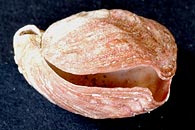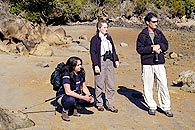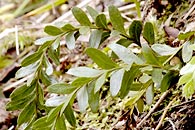|
|
Ich kenne mich schnell aus in neuen Gefilden.
Trotzdem gehe ich gerne auf eine geführte Tour, wenn ich etwas Neues
entdecken will. Es ist erstaunlich, wie viel man übersieht, wenn man sich
alleine durch ein unbekanntes Gebiet bewegt. Nicht dass man sich darüber
im klaren wäre, was einem alles entgangen ist.
Ich war schon einige Male auf Ulva, dem Schutzgebiet vor der Küste von
Stewart Island, und habe dabei die älteste Pflanze der Welt übersehen.
Schrecklich, das kann nicht so weiter gehen, habe ich mir gesagt, und eine
Tour gebucht. Die erste Erleuchtung kam bereits nach 10 m auf Ulva. Die
schwarzen Stämme der Büsche gleich nach dem Landungssteg waren nicht
unvorsichtigerweise angesengt worden, sondern sind eine gut eingerichtete
Futterstelle der Natur. Ein kleines Insekt steck in der Rinde und
produziert mit seinem Hinterteil einen kleinen Zuckersüssen Tropfen. Diese
Tröpfchen sind bei den Nektar fressenden Vögeln wie dem Bellbird heiss
beliebt. Ein schwarzer Pilz siedelt sich dann an und so kommen die
Sträucher zu ihrer rabenschwarzen Haut und dem wunderbaren Duft nach
Honig. Ich habe das erste Stück Weg Bellbird Lane getauft, denn da wird
von den naschhaften, musikalischen Vögeln ein ständiges Konzert gegeben.
Ich habe die Vogelwelt auf Ulva gut kennen gelernt. Die meisten davon sind
bedroht oder existieren nur in diesem Teil der Welt. Der South Island
Saddleback mit seinem braunroten Sattel, die freundlichen kleinen Stewart
Island Robin, der Futter suchende rot oder gelb gekrönte Parakeet , Brown
Creeper, Grey Warbler mit seinem melancholischen Gesang, der Kaka, die
dicke grosse Wildtaube, der Weka und die sehr seltenen Yellowhead und
Riflemen leben hier friedlich zusammen und sind geschützt vor Raubtieren.
Es hat sich nicht viel getan hier in der Pflanzen und Tierwelt seit sich
Neuseeland und Stewart Island vor 85 Mio. Jahren von Gondwanaland getrennt
haben.
Einheimisch Bäume wachsen ausgesprochen langsam und werden sehr alt. Da
gibt es Rimu, stünden sie in Europa, wären Zeuge von den Kreuzritterzügen
gewesen und hätten vielleicht sogar einen Ast als Lanze für Richard
Löwenherz geopfert. Rimu und die anderen Nadelbäume haben auch eine sehr
altertümliche Weise um sich fortzusetzen. Anstelle eines Zapfens, auf den
jeder Nadelbaum in Europa stolz gewesen wäre, produzieren diese Podocarp
Bäume eine kleine Frucht am Ende ihrer Äste. Diese Früchte sind hier
Leckerbissen für die Wildtauben und andere tierische Gourmets. Der Samen
im Kern dieser Frucht wird zusammen mit seinem persönlichen Düngerpäckchen
von den Vögeln wieder hergegeben und sichern so den Fortbestand der Art.
Mein Lieblingsbaum ist jedoch die Southern Rata. Sie hat zur
Weihnachtszeit wunderschöne dunkelrote Blüten und wird deshalb auch
Weihnachtsbaum genannt. Nicht genug damit, ihre jungen Blätter sind rot
und geben einen schönen Kontrast zum Rest des Waldes ab. Das allein macht
es jedoch nicht zu meinem Liebling. Obwohl der Rata seine Rinde in dünnen
Streifen abwirft um sauber zu bleiben, ist er ein sehr gastfreundlicher
Baum. Je älter und krummer er wird, desto mehr Platz bietet er für
Untermieter an. Es wachsen Orchideen, Farne, auch Baumfarne und andere
Bäume wie Miro, Totara oder Lancewood auf ihm, ohne zu schaden.
Schlussendlich sieht der Baum aus wie ein Mehrfamilienhaus.
Lancewood ist ein weiterer Überlebender aus der Dynosaurierzeit. In jungen
Jahren wächst er ganz gerade, ohne Seitenäste zum Licht. Seine Blätter
sind lang, gezähnt und sehr zäh. Später, wenn er eine gewisse Höhe
erreicht hat, wachsen Äste und seine Blätterwerden oval und haben keine
Zacken mehr. Sie gleichen dann Rhododendron Blättern. Diese Strategie hat
der Lancewood wahrscheinlich wegen des ancient Moa entwickelt. Der Moa war
ein gefrässiger Riesenvogel in der Art der Strausse. Die Äste und die
weicheren Blätter haben sich erst ausserhalb der Reichweite des Moa
gebildet.
Die spektakulärste Pflanze ist über 450 Mio. Jahre alt und sieht völlig
unscheinbar aus. Botaniker geraten bei ihrer Ansicht in Ekstase. Die
Pflanze hat einen unaussprechlichen Namen: „Tmesipteris tannensis”. Was
aussieht wie ein Zweig mit harten Blättern auf alle 4 Seiten, ist jedoch
ein einziger Stamm mit breiteren Auswüchsen für die Photosynthese. Die
Pflanze gehört zu den ältesten Pflanzen der Welt.
Hättet ihr diese sensationelle Pflanze ohne Guide gefunden? Ich nicht.
Etwas 570 Mio., Jahre alt sind die Brachiopods. Das sind muschelartige
Lebewesen, die ihre Schalen mit einem Scharnier zusammenhalten. Sie sehen
aus wie Aladdin’s kleines Öllämpchen. Mit etwas Glück kann man die leeren
Schalen an den verschiedenen Stränden finden.
Zurück auf Stewart Island gibt es auch einige Entdeckungen zu machen. Sam
und Billy the Bus oder Oban Tours bieten eine unterhaltsame Bustour auf
dem gesamten Strassennetz der Insel von 20 km an. Vielleicht lüften sie
sogar das Geheimnis des alten Telephon’s im Baum? Der Rest der Insel kann
per Schiff erkundet werden. Es gibt verschiedene Angebote, wie zum
Beispiel ein Glasbodenboot welches zu den Lachs- und Muschelfarmen
hinausfährt, oder Touren die weitere Sehenswürdigkeiten und historische
Orte im Paterson Inlet aufsuchen.
|
|
|
|
|
 Above:
Filmy Fern is only one cell thick. Above:
Filmy Fern is only one cell thick.
Left: Brachiopod one of the oldest creatures on earth.
Below: Tmesipteris has grown unchanged for 400 Mio years |
 |
|
  |
 |
|

|
|
|
|
|
|
A guided tour
I praise myself to be a person who knows her way about town. Still I like
going on guided tours. It is amazing how much one can overlook if one
ambles alone through an unknown territory. Not that one would know that,
nor how much was missed.
I have been several times on Ulva Island, the pest free sanctuary just off
Stewart Island and have overlooked the oldest living plant on earth.
Shocking, that would not do, I said to myself and booked a tour. I had my
first revelation already just 10 m away from the boat. The black stems of
the shrubs just off the landing were not the result of a fire some one had
ignited, but a carefully thought out feeding structure of Mother Nature.
Some tiny little insects live on the bark. They ooze a very sweet
secretion in minute little droplets, which are highly sought after by
Bellbirds and other birds with a sweet tooth. Incidentally this secretion
also attracts a little black fungus; hence the black stems and sweet honey
smell of the shrubs. I christened the first part of the walk as bellbird
lane, since these very musical birds seemed to be all around us. I have
gotten to know the birdlife on Ulva Island, which is very special, since
most of these birds are very rare or non-existent in the rest of the world.
The South Island Saddleback with its red brown saddle, the friendly and
trusting South Island Robin, the foraging red and yellow crested parakeets,
the brown creepers or grey warblers with their melancholy song, the Kaka,
Kereru the plump wood pigeon and the Weka all live happily together with
some new comers like the Yellowhead and the Riflemen.
Since New Zealand and Stewart Island have parted from ancient Gondwanaland
a mere 85 Mio years ago, not much has changed in the plant life here.
Endemic trees are very slow growing and become very old. There are Rimu,
which, if they were in Europe, would have seen the first crusades to the
Middle East. Some of their branches could have been used as lances for
Richard the Lion hearted. These trees also have a very old fashioned way
of reproducing themselves. Instead of having a cone, as every other needle
tree would be proud of, they carry one single little fruit at the end of
their twigs and call themselves a podocarp, a foot fruit. These fruits are
highly sought after by the Kereru and other birds, which excrete the seeds
firmly packed in their own little fertilizer package and thus ascertain
its survival.
My favourite tree is the Southern Rata. It has beautiful red flowers,
which gave it its nickname, the Christmas tree. This alone does not yet
make it to my special favourite. After the bloom it sprouts lovely red
young leaves. Even though it does shed its bark in long thin strips in
order to keep its outside clean, it is a very hospitable and friendly tree.
The older and more crooked it gets, the more it allows other plants to
settle on its branches. These plans are epiphytes, which means, that they
do not harm the host tree. An old rata looks like an apartment tree. It
has tenants on all levels. Some of them ferns even tree ferns, orchids,
and other trees like Lancewood trees, Rimu, Miro etc.
Talking about Lancewood, another primitive ancient tree. In its younger
stage it really looks like a long lance with some long spiky, leathery
leaves on top, no branches. Once it matures it branches out and forms
longish oval leaves, which look much, like a rhododendron. It is believed,
that this tactic was a protection against the ancient Moa, a giant
flightless bird, much like an Emu or Ostrich but bigger. The softer leaves
and branches would only have grown outside the reach of the Moa.
The most spectacular remnant from as far back as 450 Mio years looks very
nondescript. Only botanists can really appreciate its significance. It is
called an unpronounceable “Tmesipteris tannensis”. What looks like a
little twig with leaves to four sides is really just a stem with oval
extensions for the photosynthesis. It belongs to the oldest surviving
plants of the world.
Would you have been able to spot that sensational plant without a guide?
Neither would I.
Going further back in time there are three species of ancient clam-like
animals called brachiopod, which have been unchanged since 570 Mio. Years
and belong to the oldest living things on earth. The shells look like
little oil lamps from Aladdin’s cave and have hinges. They are found on
certain beaches on Stewart Island.
Back on Stewart Island there are also quite a number of hidden treasures
to be discovered. Sam and Billy the bus or Oban tours give a very
entertaining bus tour showing the sights on the whole of the 20 km of
roads. They might even tell you the story of the old telephone on the tree.
The rest of the Island is to be explored via Boat. There are a number of
offerings available, including one with a Glass bottom boat to the Mussel
and Salmon Farm, or one showing the sights of Paterson Inlet. |